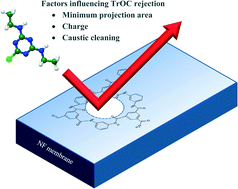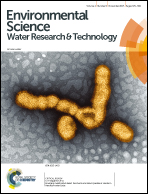Rejection of trace organic chemicals by a nanofiltration membrane: the role of molecular properties and effects of caustic cleaning
Abstract
This study aims to provide further insights to the rejection mechanisms of trace organic chemicals (TrOCs) by nanofiltration (NF). The separation mechanisms of TrOCs by an NF membrane were elucidated by assessing the role of molecular properties and the impact of caustic cleaning on their rejection. All charged TrOCs were rejected by the NF270 membrane by more than 80%. However, the rejection of positively charged TrOCs was lower than that of negatively charged TrOCs with similar molecular sizes and was similar to the rejection of neutral TrOCs. The results suggest that size exclusion, rather than electrostatic repulsion, was a major factor attributing to the rejection of these positively charged TrOCs. The results also showed that the minimum projection area was a better surrogate parameter for molecular dimensions than molecular weight. Our study highlights the need to monitor the rejection of neutral and positively charged TrOCs (particularly those that are normally moderately rejected by the membrane) following caustic cleaning.



 Please wait while we load your content...
Please wait while we load your content...